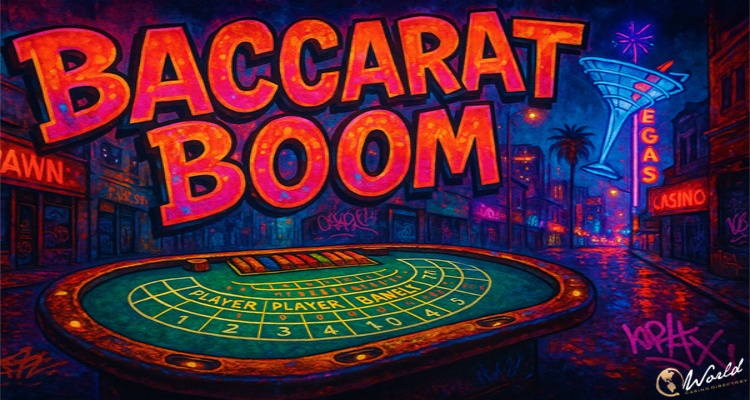Las Vegas casinos have recently reported stronger revenue figures, but the underlying story reveals a city facing ongoing declines in visitation, air travel, and non-gaming spending. Industry analysts warn that baccarat, while delivering remarkable earnings in recent months, may be disguising deeper concerns for the Strip’s long-term performance.
Baccarat Drives Gaming Wins
August was a standout month for baccarat on the Las Vegas Strip, with revenue surging 51% year-over-year to $114.4 million. From June through August, baccarat alone generated $355.3 million, a 29% increase compared to the same period in 2024. This growth came despite fewer bets being placed, as casinos benefited from an unusually high “hold” rate.
Casinos kept 18.5% of baccarat wagers in August, compared to 10.5% a year earlier. July had already shown similar results, with a 17.5% hold compared to 8.8% the prior year. Analysts noted that this shift was not due to increased betting but rather to baccarat’s inherent volatility. A handful of high rollers losing large sums can significantly tilt results, and in August, outcomes leaned heavily in the casinos’ favor.
Statewide, Nevada gaming revenue rose 5.5% to $1.22 billion, with Clark County—home to the Strip—reporting $3.34 billion in gross gaming revenue for the summer, up 4% from 2024. The Strip alone delivered $679.3 million, marking a 5.5% increase despite smaller visitor counts. The gains were bolstered by craps, which rose 5% to $30.1 million, and poker rake, which climbed 14% to $14 million. Sportsbooks also reported a sharp 178% jump in August, keeping $20.8 million in wagers.
While baccarat has helped buoy casino revenue, broader economic indicators suggest softness in the Las Vegas market. Through the first eight months of 2025, visitation fell 8%, airline passenger numbers dropped 4.5%, and revenue per available room (RevPar) declined 9%.
RevPar, which includes both gaming and non-gaming spending such as dining, entertainment, and shopping, is down 8.5% on the Strip this year. Analysts have stressed that non-gaming expenditures are particularly important since they often surpass gaming totals. The 2024 Gaming Abstract highlighted this trend, showing that Strip resorts generated nearly $21.9 billion in total revenue, with only 27%—$5.7 billion—coming from gaming.
The Las Vegas Convention and Visitors Authority (LVCVA) reported that nearly 3.2 million people visited the city in August, representing a 6.7% decline compared to the previous year. This was seen as a relative improvement after double-digit declines in June and July, although it still underscores ongoing challenges.
Industry Reactions and Promotional Efforts
Operators and analysts have pointed to multiple causes behind declining visitation: higher resort and parking fees, surcharges on dining, reduced airline capacity, and broader geopolitical issues affecting travel from nearby markets like Canada, Mexico, and Southern California. Spirit Airlines’ bankruptcy has also been a major factor, with the carrier—formerly the second-busiest at Harry Reid International Airport—seeing a decline of 1.7 million passengers in 2025. Overall, Reid Airport is down nearly 1.8 million passengers this year.
In response, Las Vegas casinos and the LVCVA have introduced promotions to draw back visitors. Last month, a five-day sales event offered over 100 deals across resorts, covering dining, shows, and other non-gaming experiences. Opinions were mixed: John Mehaffey of Vegas Advantage said the offers encouraged return trips from guests who previously felt priced out, while journalist Rob Kachelriess dismissed the promotions as “a somewhat uninspiring choice between the ‘meh’ and ‘maybe.’”
Some casinos have lowered table minimums and introduced dining specials in an effort to appeal to cost-conscious visitors. Still, industry voices caution against quick fixes. Brendan Bussmann, a Las Vegas-based consultant, emphasized the importance of long-term stability: “This is about the marathon and not the sprint by throwing quick things at a market segment. We need to direct those efforts to changing the narrative and talking about all of the good things going on in the destination.”
As The Nevada Independent reports, analysts remain divided on the city’s near-term outlook. Chad Beynon of Macquarie Securities warned that “softness from leisure (and) international customers will last through year-end following three years of growth,” though he maintained confidence in Las Vegas’ long-term prospects.
Others, like John DeCree of CBRE, believe that convention season could stabilize visitation over the next two quarters, even as pressures on leisure travelers persist. Meanwhile, the local gaming market has shown resilience, with Red Rock Resorts posting record quarterly results and reporting that properties in Summerlin and Durango are pulling visitors away from the Strip.


